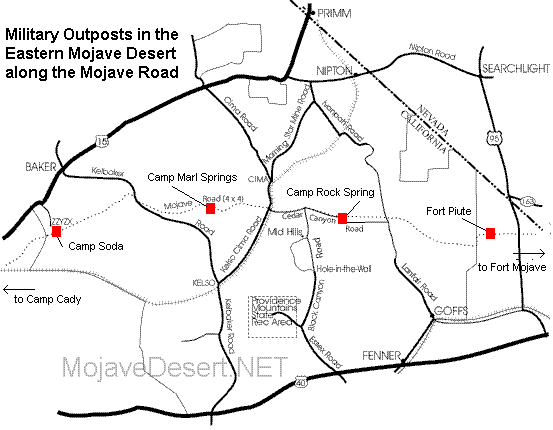Mojave National Preserve - History
19th Century Military History in the Mojave Preserve

Conflict between Native Americans and Euro-Americans was the catalyst for the establishment of a lasting federal legacy in the Mojave desert. The
Mojave attacked emigrant wagon trains in 1858, prompting a substantial military response. [7]
Major William Hoffman
led a unit of over 600 men to
the
Colorado River, homeland of the Mojave, and demanded surrender. Prudently,
the Mojave complied, and Hoffman set up a military post on the eastern
bank of the Colorado River that soon became known as Fort Mojave. The effort to supply the fort caused wagon teams from Los Angeles to cross the
eastern Mojave regularly until the start of the Civil War in 1861, and turned Beale's path into a true wagon road, easily followed. Some improvements
were made to the route at this time, such as the construction of a water stop known as Government Holes.
The U.S. military spent several months in the eastern Mojave in an ill-conceived attempt to punish Native Americans for a crime they may not have
committed. In 1860, two whites were murdered at
Bitter Springs,
on the Mormon wagon road, and the attacks were blamed on the
"Pah-Utes,"
though
contemporaries and later historians suggested that the attacks were quite possibly carried out by Mormons, rather than Native Americans. Newspapers
in southern California whipped the citizenry into a fury, and prompted the army to send a unit led by
James H. Carleton, an Army dragoon
from
Fort Tejon, California, into the desert to exact revenge on the Native Americans supposedly responsible for the attacks. Carleton's troops
built a small fort at
Camp Cady, and roamed all over the western portion of the present-day
Preserve - through Devil's Playground, around the
Granite Mountains, and across
Soda Lake. The soldiers constructed a small earthen fortification, called
Hancock's Redoubt,
at Soda Springs. Carleton chased his quarry all over the desert, and executed several in an attempt to impress the remainder with the power of
the United States military. At the end of his three-month stay in the desert, the Native American leaders arrived at Camp Cady and asked for
peace. Carleton negotiated a cease-fire, but it was ultimately ineffectual as the army did not return later (due to the Civil War) to distribute
aid as promised and uphold their end of the bargain. [8]
The Civil War prompted the military to abandon
Fort Mojave
in 1861. In mid-1863, it was re-activated with a garrison composed of California Volunteers,
to provide security for travelers to Arizona. Gold was discovered in Arizona that year and by 1864, the Mojave Road was a crucial supply line
to the territorial capital at Prescott. From 1866 to 1868, the mail was carried over the Mojave Road from California to Arizona. Native Americans
in the Mojave and in Arizona commenced hostilities, and a group attacked the garrison at Camp Cady. This emphasized the importance of having a
military escort for the mail as it crossed the desert. To support this escort effort, the military constructed small outposts
at Soda Springs, Marl Springs, Rock Spring, and "Piute" Creek. The army successfully negotiated an end to the conflict in late 1867. Shortly
thereafter, a series of heavy rainstorms left the road impassible. This factor, combined with the cumulative losses to Native Americans along
the Mojave route, caused the transfer of mail service to a different, more southerly trail. The outposts at Piute Creek, Rock Spring, Marl Springs,
and Soda Springs were abandoned. [9]
Military use of the
Mojave Road
diminished, but civilian use increased as more people were attracted to the desert area. By the
1870s, Fort Mojave was largely supplied by steamboat service up the Colorado River, but miners, prospectors, and ranchers used
the Mojave Road to cross the desert until the
Southern Pacific / Atlantic & Pacific Railroad
was completed in 1883. [10]
 Fort Piute
Fort Piute